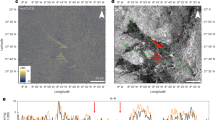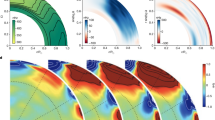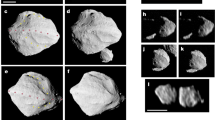Abstract
RICH clusters of galaxies are the largest bound masses in the Uni-verse, but it has been difficult to determine just how massive they are1,2. Observations of the velocities of individual galaxies, whose motions reflect the gravitational potential that they feel, have the difficulty that only the component of motion along the line of sight can be measured—the transverse component is unknown. X-ray observations seem to provide a better estimate of the mass3–6, under the assumption that the hot X-ray-emitting gas is relaxed because of its isotropic velocity dispersion, but they have been hampered by a lack of adequate simultaneous spatial and spectral resolution. Here we present a map of the distribution of X-ray temperatures in the cluster Abell 2256, which has been thought to be nearly relaxed. Our map demonstrates that this is not the case, and implies that the assumption that the cluster is relaxed will lead to an underestimate of the true mass. As most clusters show still less evidence of being relaxed than A2256, their mass estimates may have larger errors.
This is a preview of subscription content, access via your institution
Access options
Subscribe to this journal
Receive 51 print issues and online access
$199.00 per year
only $3.90 per issue
Buy this article
- Purchase on Springer Link
- Instant access to full article PDF
Prices may be subject to local taxes which are calculated during checkout
Similar content being viewed by others
References
Merritt, D. Astrophys. J. 313, 121–135 (1987).
The, L. & White, S. D. M. Astr. J. 92, 1248–1253 (1986).
Fabricant, D. & Gorenstein, P. Astrophys. J. 267, 535–546 (1983).
Hughes, J. Astrophys. J. 337, 21–33 (1989).
Henry, J. P., Briel, U. G. & Nulsen, P. E. J. Astr. Astrophys. 271, 413–420 (1993).
Allen, S. W. & Fabian, A. C. Mon. Not. R. astr. Soc. 269, 409–426 (1994).
Briel, U. G. et al. Astr. Astrophys. 246, L10–L13 (1991).
Henry, J. P. & Briel, U. G. Astr. Astrophys. 246, L14–L16 (1991).
Jones, C. & Forman, W. Astrophys. J. 276, 38–55 (1984).
Bahcall, N. A. & Lubin, L. M. Astrophys. J. 426, 513–515 (1994).
Pierce, M. J. et al. Nature 371, 385–389 (1994).
Giacconi, R. et al. Astrophys. J. 230, 540–550 (1979).
Taylor, B. G. et al. Space Sci. Rev. 30, 479–512 (1981).
Trümper, J. Adv. Space Res. 2, 241–249 (1983).
Pfeffermann, E. et al. Proc. Soc. Photo-Opt. Instrum. Engrs 733, 519–532 (1986).
Snowden, S. L., McCammon, D., Burrows, D. N. & Mendenhall, J. A. Astrophys. J. 424, 714–728 (1994).
Snowden, S. L., Plucinsky, P. P., Briel, U., Hasinger, G. & Pfeffermann, E. Astrophys. J. 393, 819–828 (1992).
Hatsukade, I. thesis, Osaka Univ. (1989).
Raymond, J. C. & Smith, B. W. Astrophys. J. Suppl. Ser. 35, 419–439 (1977).
Zimmermann, H. U., Belloni, T., Izzo, C., Kahabka, P. & Schwendker, O. Max-Planck-lnstitut für extraterrestrische Physik Rep. 244 (Garching, 1993).
Geller, M. J. Comments Astrophys. 10, 47–52 (1984).
Geller, M. J. & Beers, T. C. Publs astr. Soc. Pacif. 94, 421–439 (1982).
Oegerle, W. R., Hoessel, J. G. & Jewison, M. S. Astr. J. 93, 519–528 (1987).
Fabricant, D., Kent, S. & Kurtz, M. Astrophys. J. 336, 77–92 (1989).
Schindler, S. & Müller, E. Astr. Astrophys. 272, 137–152 (1993).
Evrard, G. in Clusters of Galaxies (eds Oegerle, W. R., Fitchett, M. J. & Daney, L.) 287–326 (Cambridge Univ. Press, 1990).
Evrard, G. in Clusters of Galaxies (ed. Durret, F.) (Frontières, Gif-sur-Yvette, in the press).
Henry, J. P. & Henriksen, M. J. Astrophys. J. 301, 689–697 (1986).
Briel, U. G., Henry, J. P. & Böhringer, H. Astr. Astrophys. 259, L31–L34 (1992).
White, S. D. M., Navarro, J. F., Evrard, A. E. & Frenk, C. S. Nature 366, 429–433 (1993).
Navarro, J. F., Frenk, C. S. & White, S. D. M. Mon. Not. R. astr. Soc. (submitted).
Miyaji, T. et al. Astrophys. J. 419, 66–77 (1993).
Author information
Authors and Affiliations
Rights and permissions
About this article
Cite this article
Briel, U., Henry, J. An X-ray temperature map of the merging galaxy cluster A2256. Nature 372, 439–441 (1994). https://doi.org/10.1038/372439a0
Received:
Accepted:
Issue Date:
DOI: https://doi.org/10.1038/372439a0
This article is cited by
-
X-ray spectroscopy of galaxy clusters: studying astrophysical processes in the largest celestial laboratories
The Astronomy and Astrophysics Review (2010)
-
Focussing in the hard x-ray band
Experimental Astronomy (1995)
Comments
By submitting a comment you agree to abide by our Terms and Community Guidelines. If you find something abusive or that does not comply with our terms or guidelines please flag it as inappropriate.



